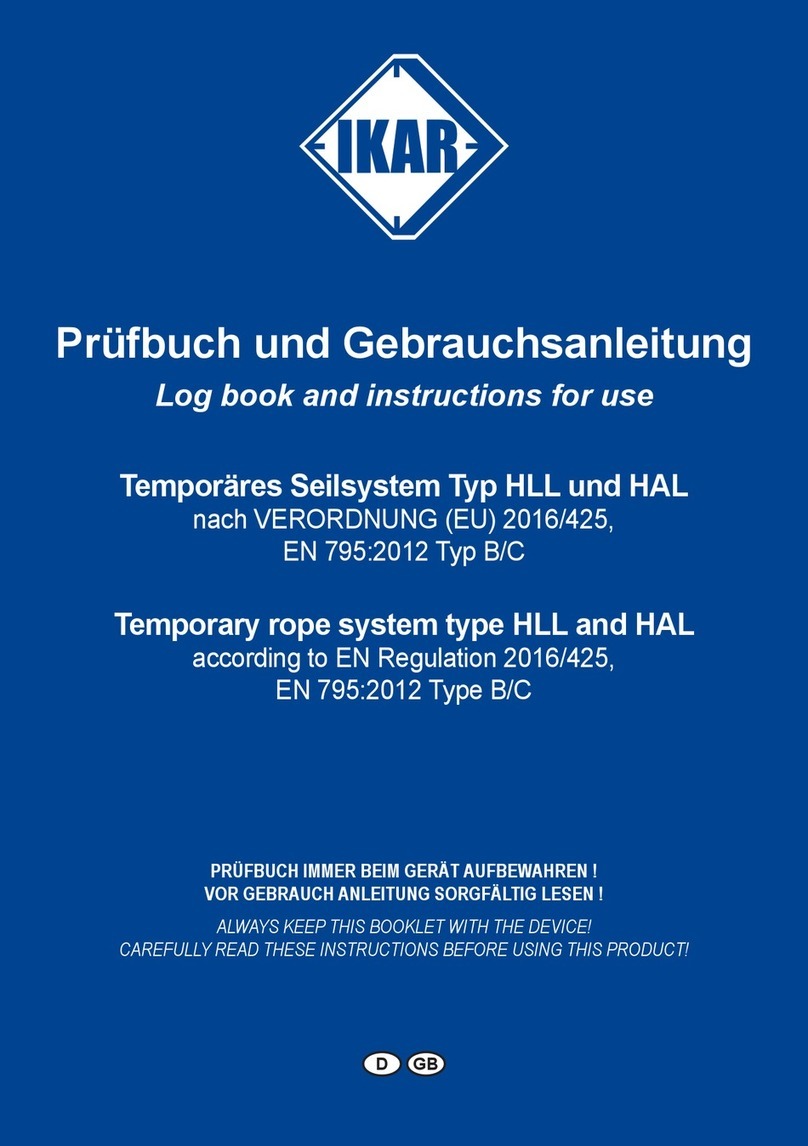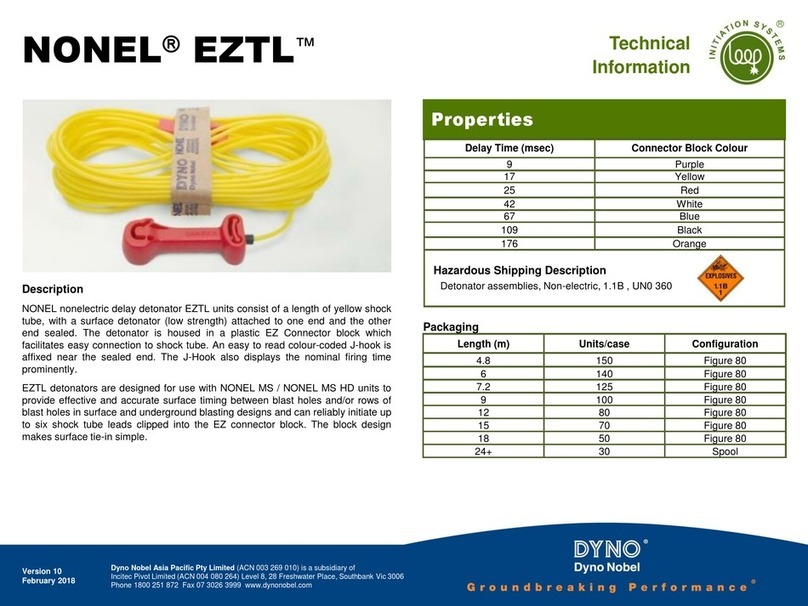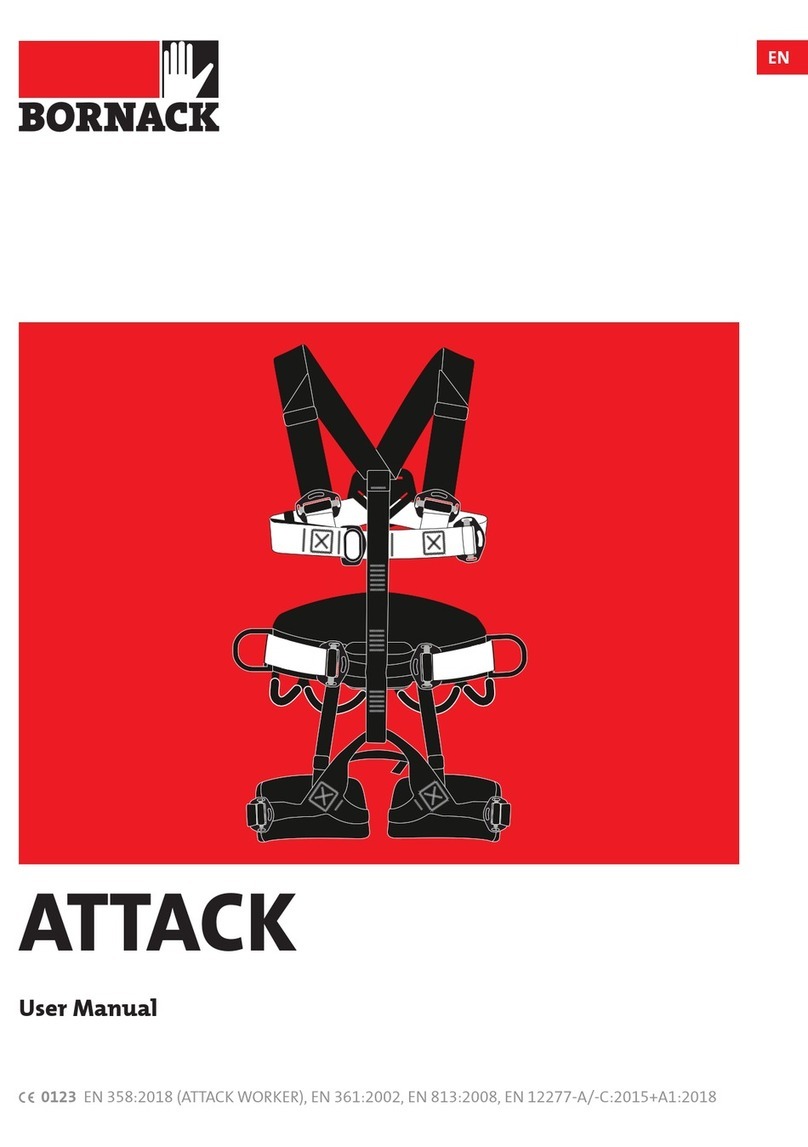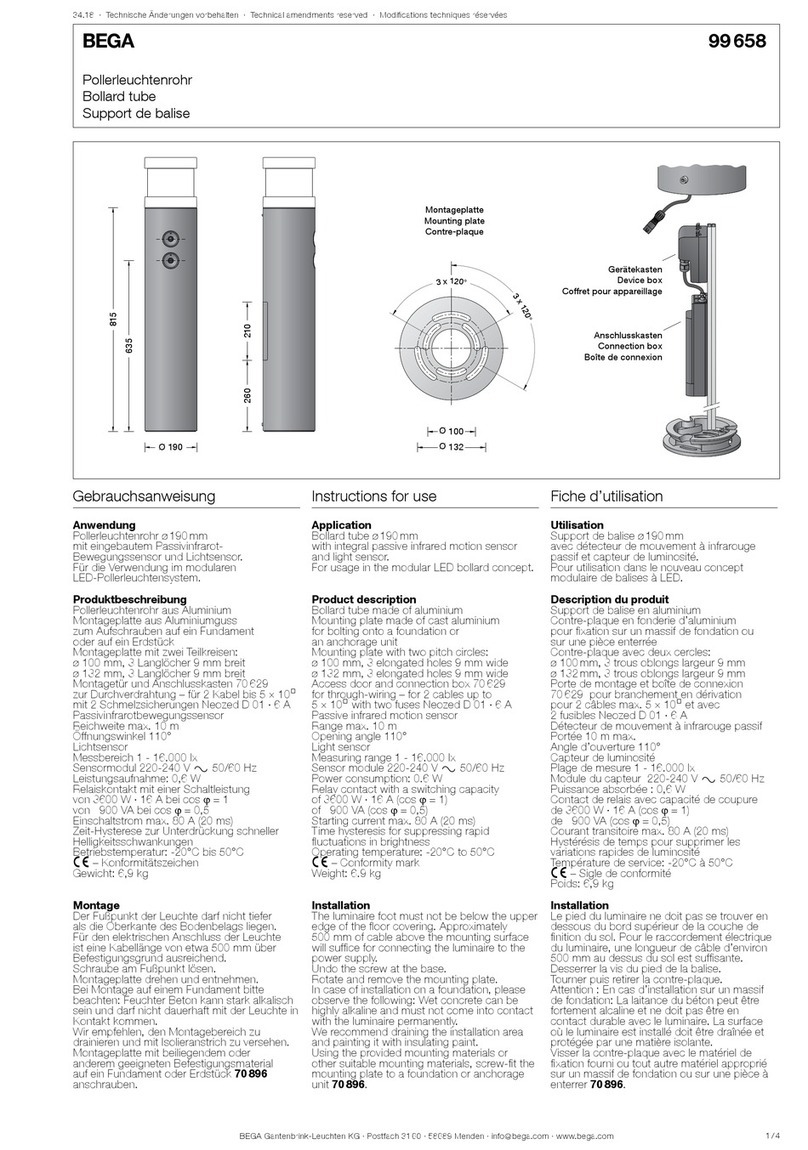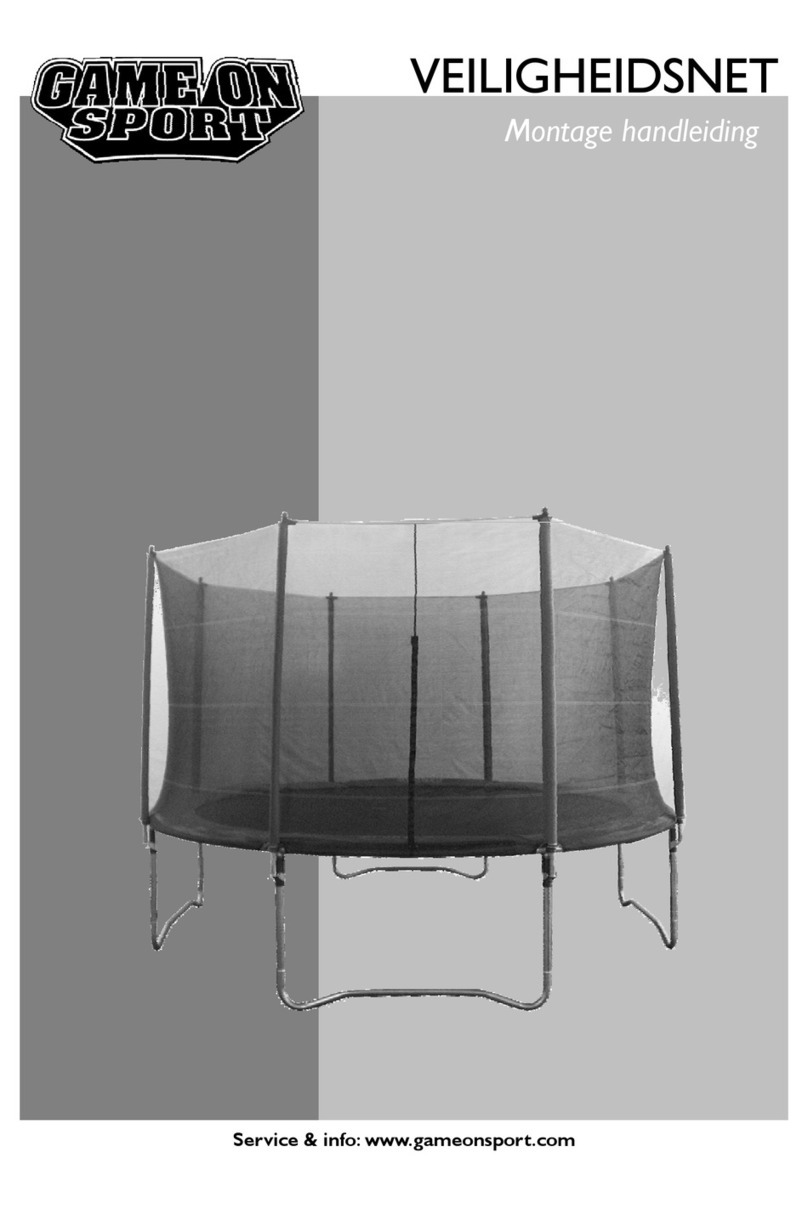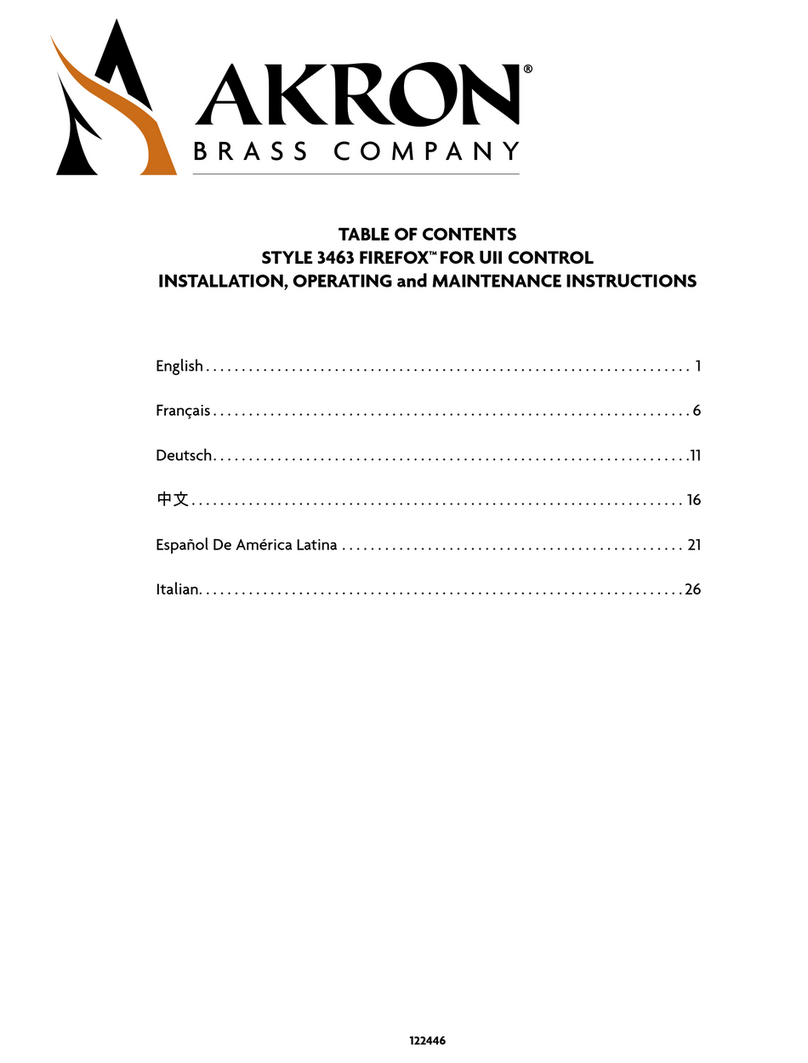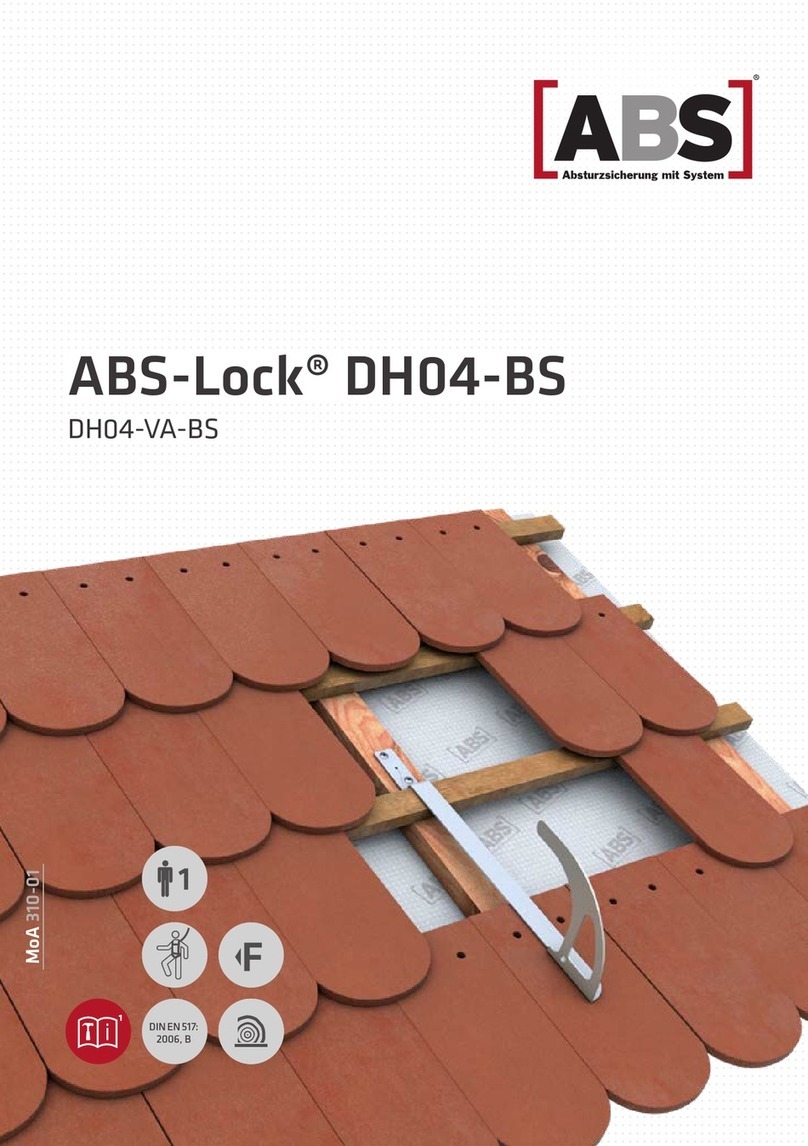IKAR ABS 5 B Product guide

1
Prüfbuch und Gebrauchsanleitung
Log book and instructions for use
Abseilgerät mit Freilauf /
Controlled Descent Device
ABS 5 B
nach / acc. to
i.A. EN 341:2011/1A,
i.A. EN 360:2002
PRÜFBUCH IMMER BEIM GERÄT AUFBEWAHREN !
VOR GEBRAUCH ANLEITUNG SORGFÄLTIG LESEN !
ALWAYS KEEP THIS BOOKLET WITH THE DEVICE!
CAREFULLY READ THESE INSTRUCTIONS BEFORE USING THIS PRODUCT!
D GB

3
Position / item
Datum/
Date:
Firma/
Company:
Lesbarkeit Typenschild/
readability label:
Sichtkontrolle/
visual inspection:
Verschleiß Bremse/
Brake wear:
Verschleiß Zahnrad/
Toothed wheel wear:
Verschleiß Gehäuse/
Housing wear:
Zustand Abfahrseil/
Abseil rope condition:
Funktion Karabiner
Carabiner hook function:
Funktionsprüfung/
Function check:
Abseilarbeit/
Abseil operation:
Sachkundiger/
Specialist:
Bemerkungen/ Remarks:
Nr. / Jahr
No. / year
Abseilgerät mit Freilauf nach EN 341:2011/1A
EN 360:2002, EN Verordnung 2016/425
Descender with Freewheel according to EN 341:2011/1A
EN 360:2002, EN Regulation 2016/425
Überwachung durch/controlled and audited by
DGUV Test Prüf- und Zertizierungsstelle des FA PSA,
D-42781 Haan/ Germany, CE 0299
Kaufdatum / date of purchase: ______________________________
Datum der Erstbenutzung / date of rst use: ________________
Konformitätserklärung/Conformity http://ikar-gmbh.de/index.php/de/service/download

33
Dieses Prüfbuch mit Gebrauchsanleitung gehört zum Abseil-Rettungsgerät ABS 5 B
und muss am Einsatzort verfügbar sein. Wird das Gerät wieder verkauft, muss diese
Gebrauchsanleitung in Landessprache beigefügt sein.
This user manual and the operating instructions are part of the descender devices for
rescue type ABS 5 B and have to be available at the site of operation.
In case the device will be resold, the operating instructions have to be available in the
respectively applicable national language.

44

5
D
GB
Inhaltsverzeichnis / Directory
Prüfbuch / Log book ............................................................................... 2 - 3
Kennzeichnung / labeling ...................................................................... 6 - 7
................................................................................................ 8 - 10
.............................................................................................. 11 - 13

6 7
Kennzeichnung des ABS 5 B / Label of the ABS 5 B:
1. Überwachende Stelle - Controlling Notied Body
2. Seriennummer - Serial Number
3. Seillänge/Bandlänge - Maximum Lifeline Length
4. Typenbezeichnung - Product Code
5. Produkt - product
6. Norm/Jahr - standard/year
7. Nächste Revision - date of next inspection
8. Gebrauchsanweisung beachten - consider instructions for use
9. Herstelldatum - date of manufacture
10. Hersteller - manufacturer
11. Max/Min Nennlast - Max/Min user Weight
12. Siehe Gebrauchsanleitung - As used in User Instructions
1
2
3
4
56
7
8
9
10
11
12
0299
EUROPA
EN 795
128 kg 40 kg
-4 +25
IKAR EN Typenschild 460000005B
ABS 5
IKAR GmbH ·Nobelstrasse 2 ·36041 Fulda
www.ikar-gmbh.de
Layout date: 18.09.2019
approved for print:
date: ____________________
signature: ____________________
Text
IKAR Blau Label Pantone 2945 C
Pantone 485 (Pictogram)
Pantone 361 (Pictogram)
Cut Contour
Pantone 429 (Pictogram)
Material: Oracet 3951GHT-000
Untergrund: Aluminium
460000005B
Abseilgerät mit Freilauf
i.A. EN 341:2011/1A i.A. EN 360:2002
Gerätetyp: ABS 5 B
Max. Abseilhöhe: 11 m
Max./Min-Nennlast:128 kg / 40 kg
Serien-Nr.: XXXXXX
Herstelldatum: 11/2015
D GB

7
ABS 5 B:
Gri -
Handle /
Attachment
Point
Digitalanzeige /
Digital Counter
Kennzeichnung /
Product Label
Verbindungselement zur
Verbindung am Gurt /
Connector for
connection
to safety harness
0299
EUROPA
EN795
128 kg 40 kg
-4 +25
IKAR EN Typenschild 460000005B
ABS 5
IKAR GmbH ·Nobelstrasse 2 ·36041 Fulda
www.ikar-gmbh.de
Layout date: 18.09.2019
approved for print:
date: ____________________
signature: ____________________
Text
IKAR Blau Label Pantone 2945 C
Pantone 485 (Pictogram)
Pantone 361 (Pictogram)
Cut Contour
Pantone 429 (Pictogram)
Material: Oracet 3951GHT-000
Untergrund: Aluminium
460000005B
Abseilgerät mit Freilauf
i.A. EN 341:2011/1A i.A. EN 360:2002
Gerätetyp: ABS 5 B
Max. Abseilhöhe: 11 m
Max./Min-Nennlast:128 kg / 40 kg
Serien-Nr.: XXXXXX
Herstelldatum: 11/2015
D GB

8 9
DEUTSCH
Gebrauchsanleitung
Einführung: Das IKAR Abseilgerät Typ ABS 5 B ist ein Absturzsicherungsgerät mit einer automatischen Abseil-
funktion und einem Freilauf für den Einzug des Verbindungsmittels ins Gerät. Das ABS 5 B kann z.B. bei Arbeiten
auf Tankwagen, in Hochregallagern, im Freizeit- und Sportbereich oder für Evakuierungsmaßnahmen eingesetzt
werden, wenn der Abseilweg nach unten frei von Hindernissen ist. Die Abseilfunktion des Gerätes ist direkt mit dem
herausziehen des Verbindungsmittels aktiviert so das kein Sturz ins Gerät erfolgt, sondern der Abseilvorgang sofort
eingeleitet wird. Das IKAR Abseilgerät ist gemäß dieser Gebrauchsanleitung bestimmungsgemäß zu verwen-
den. Die Gebrauchsanleitung ist vor der Benutzung vollständig zu lesen und inhaltlich zu verstehen (Bild 1). Ein
Rettungsplan für alle bei dem Einsatz des Gerätes möglichen Notfälle muß vorhanden sein.
Sicherheitshinweise
1. Bei Nichtbeachtung der Gebrauchsanleitung besteht Lebensgefahr! Es dürfen keine Verände-
rungen oder Ergänzungen am Abseilgerät vorgenommen werden. Bei dem Einsatz des Gerätes
können Verletzungen der Benutzer nicht ausgeschlossen werden, jedoch die Folgen möglicher
Verletzungen gemindert werden.
2. Das Gerät darf nur von Personen bedient werden, die entsprechend ausgebildet und sicher im
Umgang mit dem Gerät sind. Gesundheitliche Beeinträchtigungen dürfen nicht vorliegen! (Alko-
hol-, Drogen-, Medikamenteneinuß- oder Herz-Kreislaufprobleme)
3. Das Gerät ist nur für die Benutzung von Personen zugelassen, ein senken von Lasten ist nicht
zulässig (Bild 3). Die Höchstlast des Gerätes ist 128 kg, die minimale Last ist 40 kg, die maximal
mögliche Abseilhöhe ist 11 m (Bild 4).
4. Vor jeder Benutzung ist die Lesbarkeit der Produktkennzeichnung und des digitalen Zählwerks
zu kontrollieren sowie eine Sicht- und Funktionsprüfung des Absturzsicherungsgerätes Typ
ABS 5 B durchzuführen. Hierfür das Gerät an einen geeigneten Punkt anschlagen und an dem
herauslaufendem Band ziehen. Es muß sich ein spürbarer Bremswiderstand entwickeln (Bild 5).
Das Band bei dem Einzug nicht loslassen, sondern ins Gehäuse geführt einlaufen lassen (Bild
12). Die Verbindungselemente nach EN 362 auf einwandfreie Funktion prüfen (selbstschliessend,
verriegelbar). Alle Anbauteile müssen festsitzen.
5. Vor jeder Benutzung ist das Band in seiner gesamten Länge und im vollen Umfang auf einwand-
freien Zustand zu prüfen. Ein Gerät mit einem beschädigten Band darf nicht eingesetzt werden
(Bild 6). Ausgenommen sind Geräte die in einem speziellen, unbeschädigten Aufbewahrungsbeu-
tel versiegelt (eingeschweißt) sind.
6. Bestehen Zweifel hinsichtlich des sicheren Zustandes des Gerätes, ist es der Benutzung zu
entziehen und einem Sachkundigen - vom Hersteller ausgebildet - zur Prüfung vorzulegen. Der
Sachkundige entscheidet über die weitere Benutzung.
7. Das Gerät niemals eigenmächtig öffnen oder reparieren (Bild 2). Dies dürfen nur Sachkundige -
die durch den Hersteller entsprechend ausgebildet und autorisiert sind (Punkt 6).
8. Das Gerät ist nach Bedarf, bei erreichen der maximal möglichen Abseilarbeit (Anzeige auf dem
digitalen Zählwerk 67.997), mind. jedoch alle 12 Monate durch einen Sachkundigen (Punkt 6)
zu prüfen. Dies ist im Prüfbuch zu dokumentieren! Sind Geräte speziell verpackt und versiegelt,
können gegebenenfalls die Prüffristen durch den Hersteller verlängert werden.
9. Der geprüfte Temperatureinsatz- und Lagerbereich des Gerätes liegt zwischen - 4 und + 50º
Celsius (Bild 7). Bei Einsatztemperaturen unter 0° Celsius und Nässe können Funktionsstörungen
bzw. Versagen des Abseilgerätes durch Vereisung des Seiles auftreten. Trocken gehaltene Geräte
funktionieren auch bei großer Kälte.
10. Es darf nur das IKAR Gurtband als Abfahrband zum Einsatz kommen. Die Ablegereife des Ban-
des wird bei der jährlichen Prüfung durch den Sachkundigen festgestellt.
11. Wir gehen bei dem Abseilgerät Typ ABS 5 B und dem einziehbaren Verbindungsmittel von 10
Jahren Benutzungsdauer aus. Die tatsächliche Lebensdauer jedoch wird bei den Prüfungen ent-
sprechend Punkt 6 bis 8 dieser Gebrauchsanleitung durch die sachkundige Person festgestellt.
12. Abseilgeräte, die fest an einem Arbeitsplatz installiert sind und dort zwischen Inspektionen in
Position gelassen werden sind auf geeignete Weise gegen Umwelteinüsse zu schützen (z. B.
versiegelt in besonderen Verpackungen und wettergeschützten Behältern)
128 kg 40 kg
-4 +25
1
7
6
5
4
3
2

9
DEUTSCH
13. Das Gerät kann vertikal an einem oberen Anschlagpunkt eingesetzt werden (Bild 8). Läuft hierbei
das Gurtband über scharfe oder raue Kanten, ist zum Schutz des Bandes ein entsprechender
Kantenschutz einzusetzen.
14. Für das Gerät ist ein ausreichend tragfähiger Anschlagpunkt zu wählen (Bild 8). Die Befestigung
erfolgt mittels Verbindungselement nach EN 362 und ohne das der Abseilvorgang dabei behindert
wird. Die Sicherung des Verbindungselementes ist stets zu schließen um ein unbeabsichtigtes
Öffnen zu verhindern. Im Ideal Fall sind Anschlageinrichtungen nach EN 795 zu wählen. Das
Gerät möglichst senkrecht, oberhalb des Benutzers anschlagen (Bild 9).
15. Wird in Deutschland ein Anschlagpunkt an einer bestehenden Konstruktion gewählt, so muss
dieser mindestens einer Belastung von 6 kN stand halten, nachgewiesen durch die geltenden,
technischen Baubestimmungen (DGUV Regel 112-198). Das Abseilgerät kann mittels Anschlag-
hilfen der EN 354, EN 795 Kl. B, EN 362 so mit dem Anschlagpunkt verbunden werden, das der
Abseilvorgang nicht behindert wird. Die Gebrauchsanleitungen der verwendeten Anschlaghilfen
sind zusätzlich zu beachten!
16. Alle Personen die z.B. an einer Rettungsmaßnahme oder unterstützend am Einsatz des Gerätes
beteiligt sind, müssen selbst gegen Absturz gesichert sein und eine ständig mögliche Kommuni-
kation (z.B. direkter oder indirekter Sicht- oder Funkkontakt) mit der zu rettenden Person muss
sichergestellt sein. Erfolgt die Absturzsicherung mit persönlichen Absturzschutzsystemen sind die
Anforderungen an die Anschlageinrichtung entsprechend den gültigen technischen Regelwerken
zu erhöhen.
17. Das Abseilgerät ist ein selbsttätig wirkendes Abseilgerät. Bei dem automatischen Bremsvorgang
wird durch Reibung Wärme erzeugt. Bauteile des Gerätes die beim Abseilvorgang durch den
Benutzer berührt werden müssen erwärmen sich nicht über 48° C. Andere Bauteile werden
erheblich wärmer. Um Verbrennungen bei Berührung zu vermeiden, sind unbedingt geeignete
Schutzhandschuhe zu tragen.
18. Der Abseilvorgang kann nicht kontrolliert werden! Der Abseilweg muss aus diesem Grund
zwingend frei von Hindernissen sein (Bild 10). Das Abseilgerät Typ ABS 5 B hat eine zusätzliche
Auffangfunktion die bei einer Überbelastung des Gerätes, z.B. Überschreiten der zulässigen
Abseilarbeit oder ein zu hohes Gewicht des Benutzers automatisch aktiviert wird. Dabei wird der
Abseilvorgang gestoppt und der Benutzer hängt in seinem Auffanggurt.
19. Personen die längere Zeit in einem Auffanggurt hängen, können ein Hängetrauma (orthostatischer
Schock) erleiden. Ein längeres Hängen als 15 Minuten ist zu vermeiden. Rettung unverzüglich
einleiten, Person nach der Rettung nach den speziellen Regeln der „Ersten Hilfe“ lagern.
20. Nicht über Gefahrstoffen oder Hindernissen abseilen (Bild 10).
21. Das Verbindungsmittel wird mittels eines Verbindungselementes an die geeignete Öse des
Auffanggurtes des Benutzers angeschlossen (Bild11). „Schlaffbandbildung“ zwischen Person und
Anschlagpunkt ist unbedingt zu vermeiden. Es dürfen nur Auffanggurte nach EN 361 (Bild 11)
oder Rettungsgurte nach EN 1497 verwendet werden. Die Gebrauchsanleitung des Auffanggurtes
ist zusätzlich zu beachten.
22. Wettereinüsse, z. B. starker Wind und technische Gegebenheiten z.B. zu geringes Gewicht des
Benutzers, zu hohes Gewicht des Benutzers können den Abseilvorgang negativ beeinussen.
Anwendung
23. Funktionsprüfung gemäß Punkt 4 durchführen. Das Abseilgerät ABS 5 B mittels Verbindungs-
element EN 362/Anschlaghilfe EN 795 oder EN 354 mit dem oberen Anschlagpunkt verbinden.
Das Verbindungselement des auslaufenden Bandes wird an die Ring- oder Auffangöse des
Auffanggurtes des Benutzers angeschlossen. Bei einem vertikalen Aufstieg wird das Gurtband
automatisch in das Gerät eingezogen. Verliert der Benutzer beim Aufstieg den Halt, wird der
Benutzer sofort abgeseilt.
Achtung: der Abseilvorgang kann nicht beeinusst werden.
Nach erreichen z.B. eines oberen Arbeitsbereiches ist ein freies Bewegen des Benutzers im Ein-
und Auszugsbereich des Gerätes möglich. Wird bei der Bewegung das Gurtband aus dem Gerät
gezogen, spürt der Benutzer den Bremswiderstand des Gerätes. Verliert der Benutzer bei der
Bewegung das Gleichgewicht wird der Benutzer sofort abgeseilt.
EUROPA
EN 795
10
9
8
12
11

10 11
Achtung: der Abseilvorgang kann nicht beeinusst werden.
24. Evakuierungsmaßnahme einer Person mit dem ABS 5 B: Funktionsprüfung gemäß Punkt 4 durchführen. Das
Abseilgerät ABS 5 B mittels Verbindungselement EN 362/Anschlaghilfe EN 795 oder EN 354 mit dem oberen
Anschlagpunkt verbinden. Das Verbindungselement des auslaufenden Bandes wird an die Ring- oder Auf-
fangöse des Gurtes des Benutzers angeschlossen (Bild 15). Der Benutzer begibt sich in die Abseilposition.
Ist der Benutzer zusätzlich mit einem Persönlichen Absturzschutzsystem verbunden, ist dieses auszuhängen
und der Abseilvorgang ist durch einen Schritt von dem Ausgangspunkt weg einzuleiten. Achtung: Der
Abseilvorgang kann nicht beeinusst werden!
25. Bei der Benutzung des Absturzsicherungsgerätes darf die maximal mögliche, zu verrichtende Abseilarbeit
nicht überschritten werden. Bei erreichen der maximal möglichen Abseilarbeit zeigt das digitale Zählwerk den
Zählerstand 67.997 Trommelbewegungen.
Orientierungshilfe für die Benutzungsplanung des Absturzsicherungsgerätes ABS 5 B, Werte nach i.A. EN
341:2011/1A für das Erreichen der zulässigen Abseilarbeit (W) aus max.
Abseilhöhe 11 m max. 15.000.000 Joule
Mindestlast 40 kg ................. 38.226 Abseilmeter (3475 Abseilvorgänge) oder bei
Höchstlast 128 kg .................. 11.946 Abseilmeter (1085 Abseilvorgänge)
Die Formel zur Berechnung der Abseilarbeit (W) lautet: W (joule) = m x g x h x n
W = Masse x g (9,81 m/s²) x Abseilhöhe x Abseilvorgänge
Begriffe:
W = Abseilarbeit (Joule), m = Masse (kg), g (Fallbeschleunigung) = 9,81m/s², h = Abseilhöhe (m), n = Anzahl
Abseilvorgänge
Achtung: Beim Erreichen der maximal zulässigen Abseilarbeit ist das Gerät mit dem entsprechenden Vermerk im
Prüfbuch immer an den Hersteller zu senden!
Lagerung und Transport des Gerätes
Das Gerät, Seil und Zubehör ist vor negativen Einüssen zu schützen. Zu diesen Einüssen zählen u. a. Hitze oder
Kälte, elektrische Einüsse, Funken, starke Sonneneinstrahlung (ultraviolette Degradierung), Stöße, Herunterfal-
len, scharfe oder spitze Gegenstände, Nässeeinwirkung oder sonstige mechanische oder chemisch aggressive
Einwirkungen. Das Gerät ist bei der Lagerung und dem Transport grundsätzlich in einer geeigneten oder in der
durch den Hersteller vorgegebenen Verpackung zu lagern und zu transportieren. Die Lagerung hat dunkel und
trocken zu erfolgen (Idealfall).
Reinigung
Nach dem Gebrauch empfehlen wir, das Gerät gegebenenfalls zu reinigen. Band mit milder, lauwarmer Seifenlau-
ge abreiben, klar spülen und trocknen. Die Trocknung ist ausschließlich auf natürliche Weise durchzuführen, d.h.
nicht direkt über Wärmequellen aufhängen. Absturzsicherungsgerät in trockenen, luftigen und dunklen Räumen
lagern (Idealfall). Kontakt mit Säuren, ätzenden Flüssigkeiten und Ölen vermeiden. Wird vom Idealfall abgewichen
und das Abseilgerät ständig der Witterung ausgesetzt, besteht die Möglichkeit das das Gerät und das Gurtband die
maximal mögliche Benutzungsdauer nicht erreichen kann.
Vor der Verwendung von Desinfektionsmitteln ist aufgrund der komplexen gesetzlichen Produkteinstufungen nach
den speziellen Anwendungen und den Inhaltsstoffen Kontakt mit dem Hersteller auf zu nehmen.
Zubehör
Hinweis: Um eine negative Beeinussung der sicheren Funktion der Abseilgeräte zu verhindern darf nur vom
Hersteller zugelassenes Zubehör (z.b. Rettungsklemmen nach DIN 19428:2018, Schutzhauben, Halterungen, etc.)
verwendet werden. Der Hersteller haftet nicht für Schäden an Leib und Leben des Anwenders wenn dieser nicht
zugelassenes Zubehör verwendet.
DEUTSCH

11
ENGLISH
Instruction manual
Introduction: The IKAR type ABS 5 B descender is a fall protection device with an automatic descending
function and a freewheel for the moving of the fastener into the device. The ABS 5 B may be used, for ex-
ample, when working on tankers, in high-bay warehouses, in recreation and sports areas, or for evacuation
measures, if the rappelling path below is free from obstacles. The descending function is directly activated
directly with the pulling out of the fastener so that no fall into the device occurs, but rather the rappelling
is initiated immediately. The IKAR descender must be properly used in accordance with this instruction
manual. The instruction manual must be read in full and understood before use Figure 1). A rescue plan
must be available for all emergencies that may occur while using the device.
Safety instructions
1. Non-compliance with the instruction manual may cause life-threatening injuries. No modications
or additions to the descender are permitted. Although injuries to the user cannot be excluded
when using the device, it is possible to reduce the consequences of possible injuries.
2. The device may only be operated by persons who are appropriately trained and can safely handle
the device. Health-related impediments must not be present! (Inuence of alcohol, drugs and
medication, or cardiovascular problems)
3. The device is only approved for the use of persons; the lowering of loads is not permitted (Figure
3). The maximum load of the device is 128 kg, the minimum load is 40 kg, the maximum possible
rappelling height is 11 m (Figure 4).
4. Before each use, the readability of the product identication and the digital counter must be
checked, and a visual and functional test of the ABS 5 B fall protection device conducted. To do
this, fasten the device at a suitable point and pull it out at the outgoing belt. A noticeable brake re-
sistance must develop (Figure 5). Do not release the webbing during insertion, but allow it to move
into the enclosure (Figure 12). Check the connection elements according to EN 362 for functioning
in a defect-free manner (self-closing, lockable). All attachments must be secured rmly.
5. Before each use, the webbing must be tested along its entire length and in its entire scope for a
faultless condition. A device with a damaged webbing must not be used (Figure 6). Exceptions to
this are devices sealed (welded) in a special, undamaged storage bag.
6. If there is any doubt as to the safe condition of the device, it must be withdrawn from use and
presented to an expert, trained by the manufacturer, for checking. The expert shall decide on the
further use.
7. Never open or repair the device by yourself (Figure 2). This may only be undertaken by qualied
persons - trained and authorised by the manufacturer (Item 6)
8. The device must be checked by a qualied person (Item 6), where required, but at least once
every 12 months, when the maximum possible rappelling (display on the digital counter 67.997)
is reached. This must be documented in the test book. If the devices are specially packaged and
sealed, the testing intervals may be extended by the manufacturer, as appropriate.
9. The tested temperature operating range and storage area of the device is between -4 and + 50
° Celsius (Figure. 7). At operating temperatures below 0° Celsius and when wet, malfunctions or
failure of the descender can occur due to icing of the rope. Devices kept dry function even at very
low temperatures.
10. Only the IKAR webbing can be used as an exit webbing. The discard state of the webbing shall be
determined by the expert during the annual inspection.
11. For the type ABS 5 B descender and the retractable fastener, we assume a 10-year period of use.
However, the actual period of use shall be determined by the expert by testing in accordance with
Items 6 to 8 of this manual.
12. Descenders permanently installed in a workplace and placed there between inspections shall
be suitably protected against environmental inuences (e.g. sealed in special packaging and
weather-proof containers)
13. The device can be used vertically at an upper anchor point (Figure 8). The device can be used
vertically at an upper anchor point (Figure 8). If in doing so the webbing runs over sharp or rough
edges, a suitable edge protector must be used to protect the webbing.
128 kg 40 kg
-4 +25
1
7
6
5
4
3
2

12 13
ENGLISH
14. Select a sufciently weight-bearing anchor point for the device (Fig. 8). The fastening is carried
out by means of a connection element (in accordance with EN 362) and without hindering the
rappelling in the process. The safety device of the connection element must always be closed in
order to prevent unintentional opening. Ideally, stop devices shall be selected in accordance with
EN 795. Sling the device as vertically as possible above the user (Figure 9).
15. If an anchor point is selected in an existing structure in Germany, it must withstand a load of
at least 6 kN, as determined by the applicable technical building regulations (DGUV (German
Statutory Accident) regulations 112-198).The descender can be connected to the anchor point by
means of slinging aids of EN 354, EN 795 class B, EN 362, so that the rappelling is not hindered.
The instructions for use of the slinging aids used must also be complied with!
16. All persons who, say, are involved in a rescue operation or assist in the use of the device, must
be anti-fall protected, and constantly possible communication (e.g. direct or indirect visual or radio
contact) with the person to be rescued must be ensured. If the fall arrest is equipped with personal
fall protection systems, the requirements for the stop device must be increased according to the
applicable technical regulations.
17. The descender is an automatically operating descender. The automatic braking process causes
heat to be generated by friction. Components of the device which have to be touched by the user
during the rappelling do not heat up above 48°C. Other components become considerably war-
mer. In order to avoid burns during contact, suitable protective gloves must be worn without fail.
18. It is not possible to control the rappelling. For this reason, the rappelling path must be absolutely
free of obstacles (Figure 10). The type ABS 5 B descender has an additional catching function
that is automatically activated when the device is overloaded – for example, if the permissible
rappelling is exceeded or in the case of excessively high weight of the user. In these cases, the
rappelling is stopped and the user hangs in his safety harness.
19. Persons who spend longer periods in a safety harness may experience suspension trauma (or-
thostatic shock). Hanging longer than 15 minutes must be avoided. Commence rescue promptly;
after rescue, position the person according to the special First-Aid rules.
20. Do not rappel over hazardous substances or obstacles (Figure 10).
21. The rappelling rope is connected to the appropriate eyelet of the safety harness of the user by
means of a connection element (Figure 11). „Slack formation“ between the person and the anchor
point must be avoided. Only safety harnesses in accordance with EN 361 (Figure 11) or rescue
webbings in accordance with EN 1497 may be used. The instructions for use of the safety harness
must also be complied with.
22. Weather inuences (e.g. strong winds) and technical factors (e.g. excessively low weight of the
user, excessively high weight of the user) can adversely affect the rappelling.
Application
23. Perform a function check as described in Item 4. Connect the ABS 5 B descender to the upper
anchor point using the EN 362 connection element / EN 795 or EN 354 slinging aid. Connect the
connection element of the outgoing belt to the ring or fall arrest eyelet of the user‘s safety harness.
In the case of a vertical ascent, the webbing is automatically inserted into the device. If the user
loses the stop during the ascent, the user is immediately rappelled. Caution: It is not possible to
inuence the rappelling. After reaching, say, an upper working area, the user is free to move in
the feed and extension range of the device. If the webbing is pulled out of the device during mo-
vement, the user senses the brake resistance of the device. If the user loses his balance during
movement, the user is immediately rappelled.
Caution: It is not possible to inuence the rappelling.
24. When using the fall protection device, the maximum possible rappelling to be carried out must not
be exceeded. When reaching the maximum possible rappelling, the digital counter displays the
counter reading 67.997 drum movements.
EUROPA
EN 795
10
9
8
12
11

13
Orientation aid for the usage planning of the ABS 5 B fall protection device, values according to EN
341:2011/1A for reaching the permissible rappelling (W) from max. rappelling height of 11m max. 15,000,000
joules
Minimum load 40 kg ......................... 38.226 rappelling meters (3.475 rappellings) or at
Maximum load 128 kg........................11.946 rappelling meters (1.085 rappellings)
The formula for calculating the rappelling (W) is: W (joule) = m x g x h x n
W = Mass x g (9,81 m/s²) x Rappelling height x rappellings
Terms:
W = rappelling (joule), m = mass (kg), g (gravitational acceleration) = 9.81m/s², h = rappelling height (m),
n= Number of rappellings
Caution: When the maximum permissible rappelling is reached, the device must always be sent to the manufactu-
rer with the corresponding note in the test book.
Storage and transport of the device:
The device, rope and accessories must be protected against negative inuences. These inuences include heat or
cold, electrical inuences, sparks, strong solar radiation (ultraviolet degradation), impacts, dropping, sharp or poin-
ted objects, moisture or other mechanical or chemically aggressive effects. The device should always be stored
and transported in an appropriate packaging or in the packaging specied by the manufacturer. The storage should
take place in a dark and dry place (ideal case).
Cleaning:
After use, we recommend cleaning the device, as required. Wipe the webbing with a mild, lukewarm soap solution,
then rinse with clear water and dry. Drying is to be performed exclusively in a natural way, i.e. do not hang directly
over heat sources. Store the fall protection device in an dry, airy and dark place (ideal scenario). Avoid contact with
acids, corrosive liquids and oils.
If the ideal scenario is deviated from and the descender is constantly exposed to the weather, it is possible that the
device and the webbing will not reach the maximum possible period of use.
Before using disinfectants, you have to contact the manufacturer due to the complex legal product classications
based on the specic applications and constituents.
Accessories
Please note: In order to prevent a negative impact on the safe function of the fall arresting devices, it is only per-
mitted to use accessories approved by the manufacturer (e.g. rescue clamps to DIN 19428:2018, protective covers,
etc.). The manufacturer is not liable for any accidents involving the life and limb of the user if using non-approved
accessories.
ENGLISH

14 15

15

Baumusterptüfende Stelle /
Engaged body:
DEKRA EXAM GmbH
Dinnendahlstraße 9
D-44809 Bochum / GERMANY
CE0158
Überwachung durch/
controlled and autited by:
DGUV Test
Prüf- und Zertizierungsstelle
des FA PSA
D-42781 Haan / GERMANY
CE0299
Hersteller / Manufacturer:
IKAR GmbH
Nobelstr. 2
36041 Fulda
GERMANY
Tel.: +49 (0)661 22050
www.ikar-gmbh.de
Pruefbuch_IKAR_ABS_5B_v3.3_DE_GB_05112019
Table of contents
Languages:
Other IKAR Safety Equipment manuals

IKAR
IKAR HAS 9 Product guide
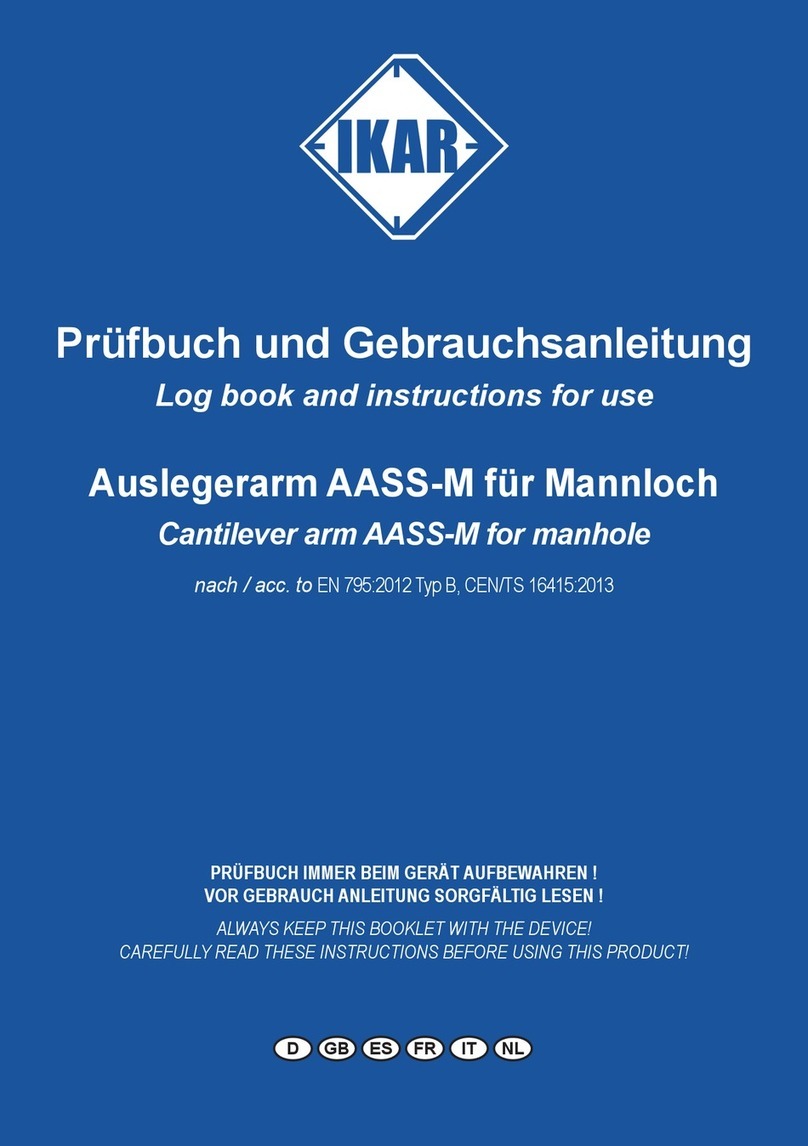
IKAR
IKAR AASS-M Product guide

IKAR
IKAR IK F K User manual
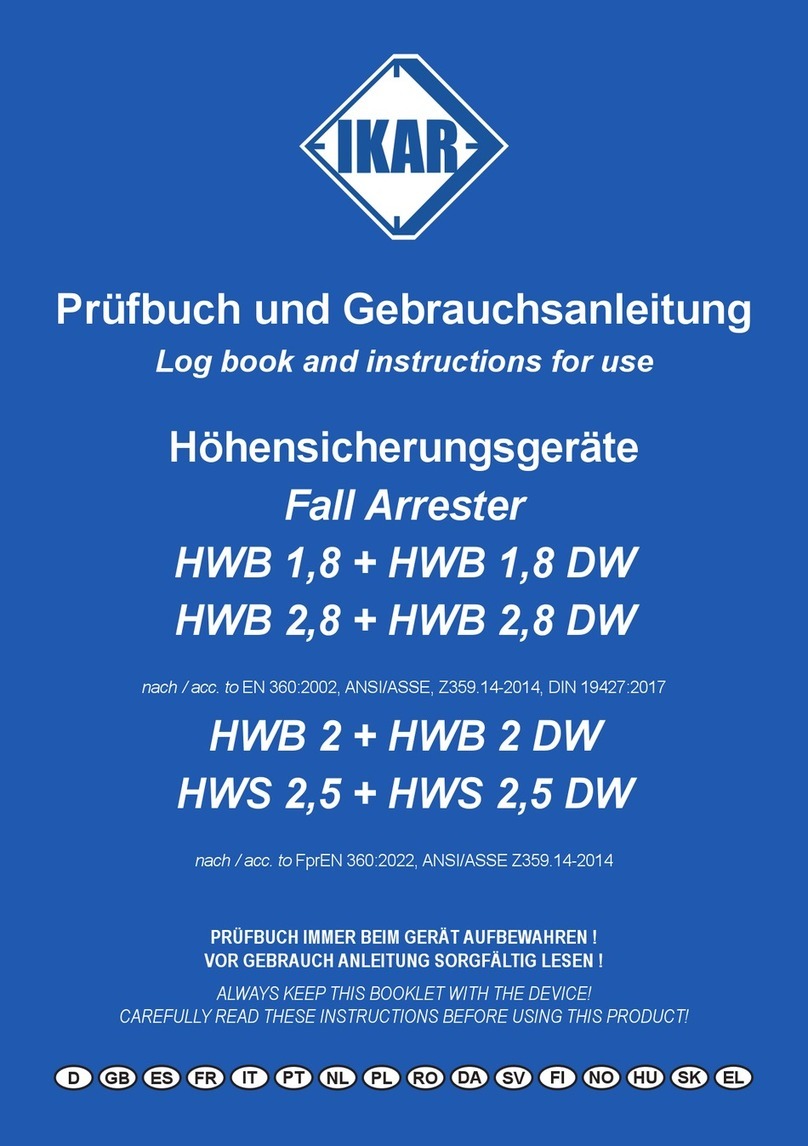
IKAR
IKAR HWB 2,8 DW Product guide
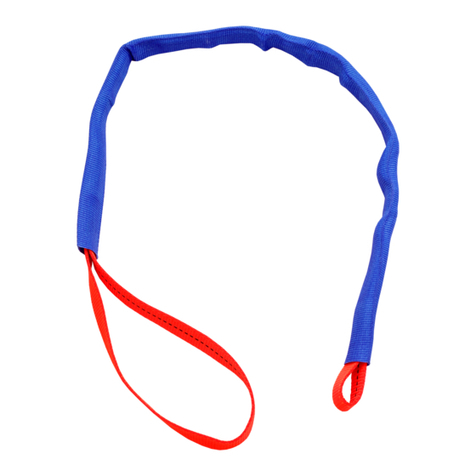
IKAR
IKAR ANCHORAGE SLINGS User manual

IKAR
IKAR AG01 Technical manual

IKAR
IKAR ASS-1 Product guide
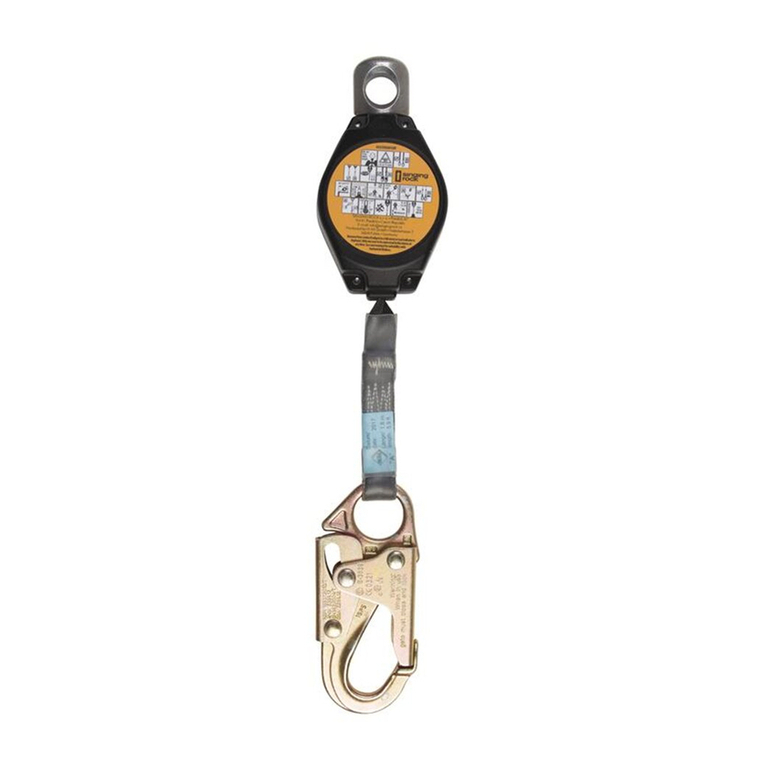
IKAR
IKAR HWB 1.8 Product guide

IKAR
IKAR HRA Series User manual
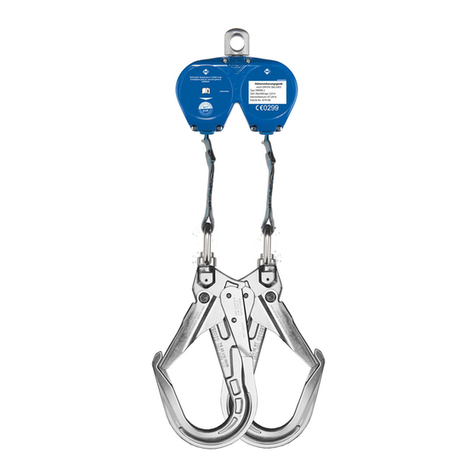
IKAR
IKAR HWDB 2 User manual
Popular Safety Equipment manuals by other brands
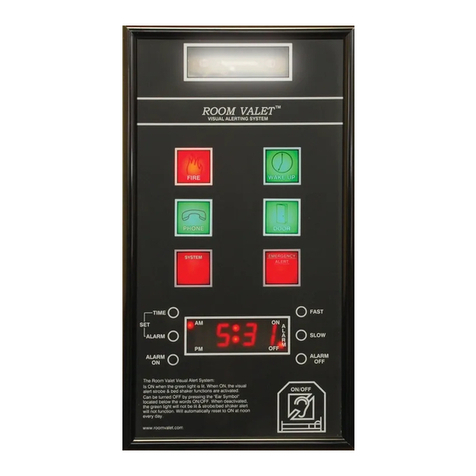
ROOM VALET
ROOM VALET Visual Alerting System instructions
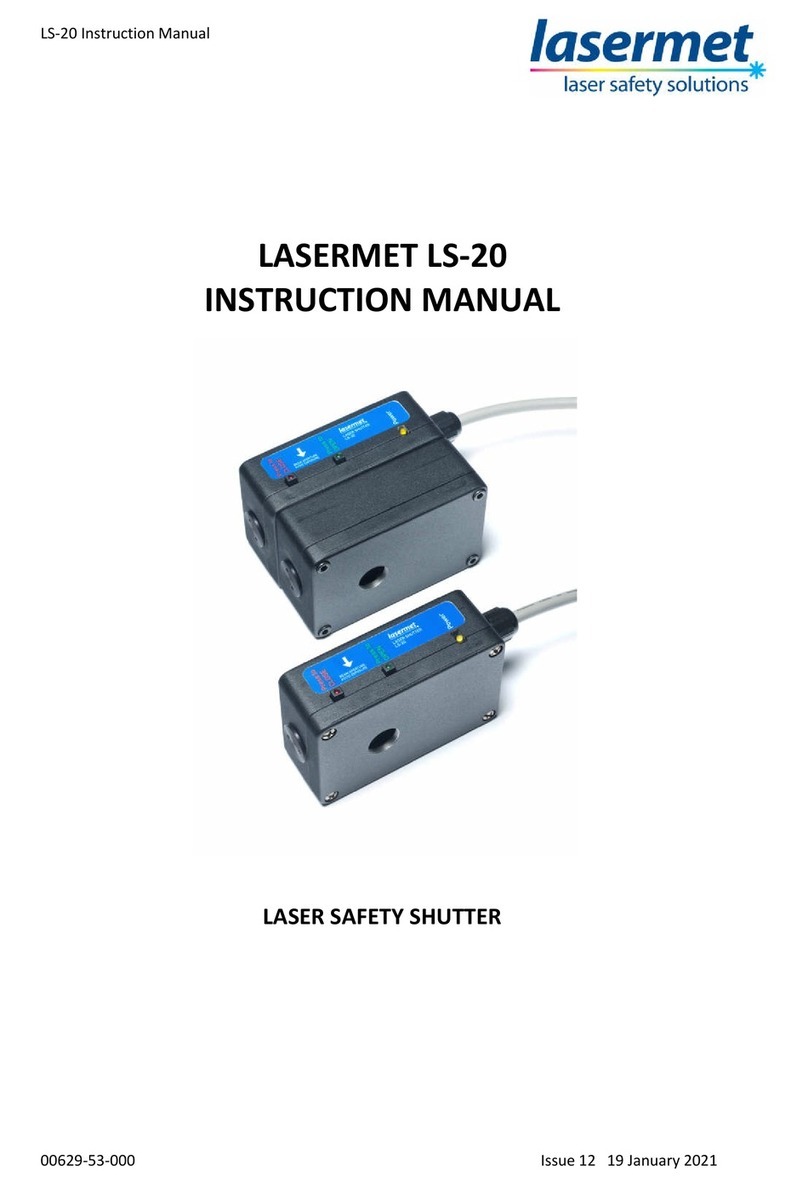
Lasermet
Lasermet LS-20 instruction manual

Falltech
Falltech For Tools 5329A5 User instruction manual
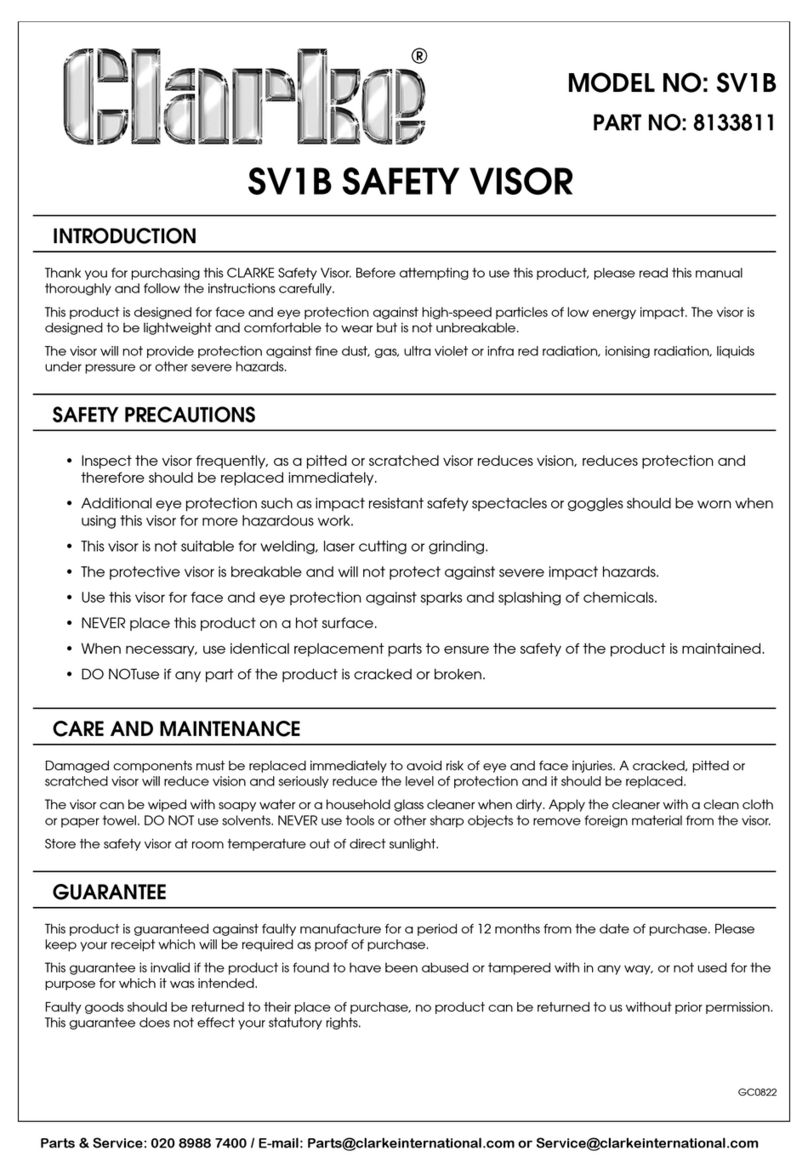
Clarke
Clarke SV1B quick start guide

Safety Technology International
Safety Technology International STI-13000 Series Installation notes

Innova
Innova XTIRPA IN-8015 Instruction and safety manual
